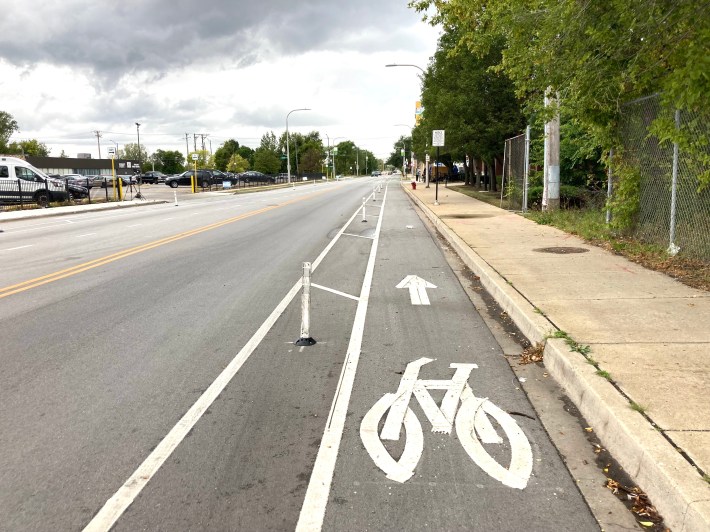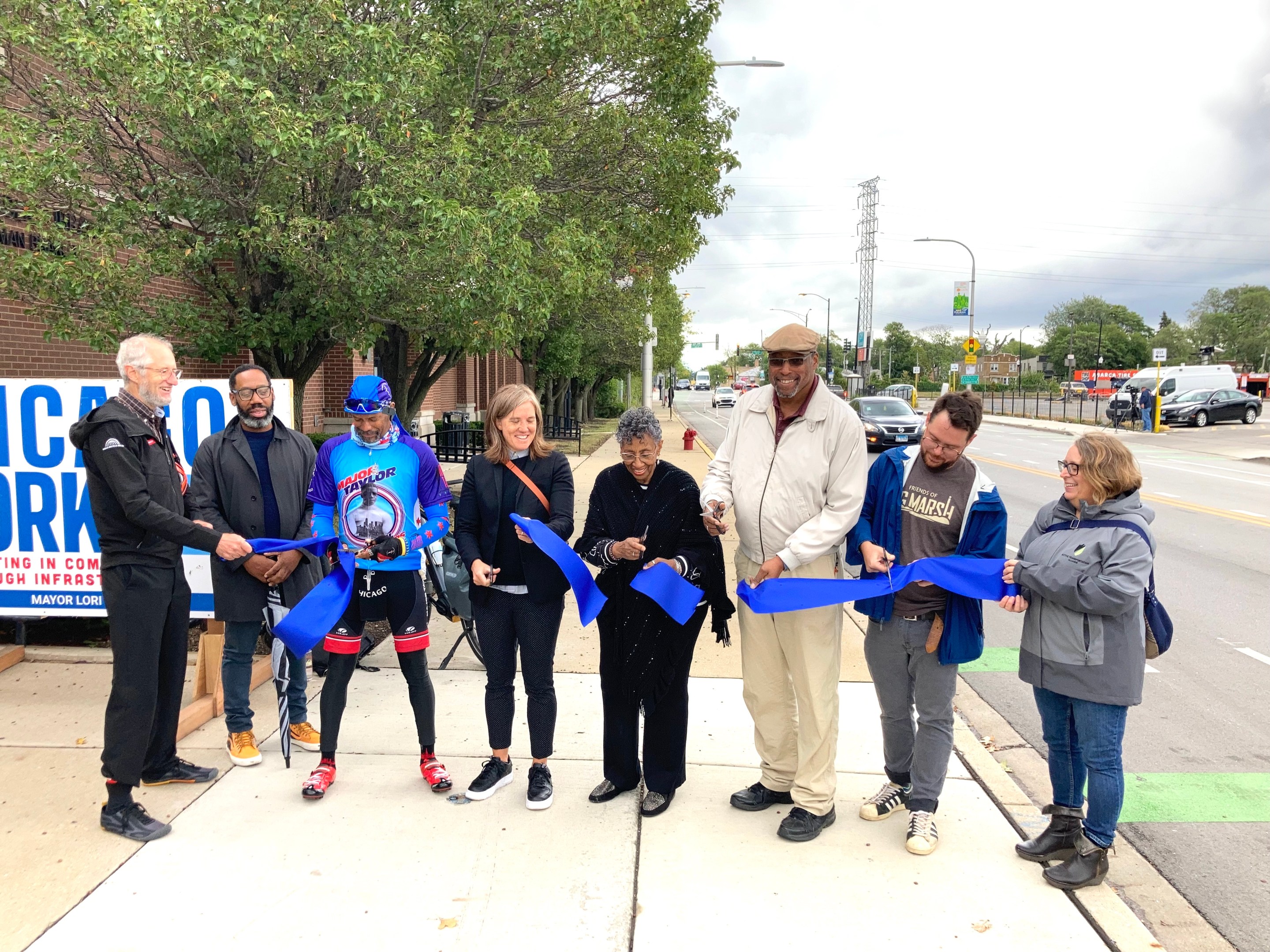For almost a month now, Streetsblog has been nagging the Chicago Department of Transportation to provide a list of recently completed or planned bikeways. This week we learned there was a pretty good reason for the delay, a surprise announcement from CDOT today that it's planning 100 miles of new and upgraded bikeways, which the department is billing as the biggest bike lane expansion in the city's history. (More on that claim in a minute.)
CDOT is currently using $17 million from Mayor Lori Lightfoot's Chicago Works capital plan for the 100 miles of improvements this year and in 2022. The projects are mostly focused on the Far South Side, the West Side, and the Mid North Side. Here's a map with existing bikeways in blue and 2021-2022 projects in red.
Today CDOT also announced the release of a short document called the Chicago Community Cycling Update, which the department described as "a blueprint for building more bikeways that puts an emphasis on community-led planning and connected neighborhood networks." You can download the doc at www.Chicago.gov/bikes.
Transportation chief Giagi Biagi announced the news at a ribbon-cutting for a new one-mile stretch of bike lanes on 119th street, delineated with flexible plastic posts, at the West Pullman library branch. Representatives from the Active Transportation Alliance, Friends of the Major Taylor Trail (which runs just north of the library), Friends of Big Marsh (the Southeast Side bike park and nature area), and the SRAM Cycling Fund, which donates money for bike projects, also participated in the press event.
Following remarks by local alderman Carrie Austin (34th), who was indicted this summer for allegedly accepting bribes and lying to FBI agents, Biagi discussed the new plan. The CDOT commissioner said that Chicago will reach 400 total miles of bikeways by the end of the year, with 12 total miles of protected bike lanes slated for completion in 2021 and 2022 – see a list of them at the bottom of this post.
CDOT has begun installing 45 miles of neighborhood bike networks in Austin, Belmont Cragin, and North Lawndale this year and next, all areas that are the focus of the Divvy expansion, with input from local community members. Biagi also touted the fact that the department installed 30 miles of new bikeways last year "at the height of the pandemic." Biagi also promised that by this time next year, every Chicago neighborhood will have Divvy service.
In addition, the department has installed about 1,100 bike parking racks since last year, with about 250 more racks slated to be by the end of this year. About 20 on-street bike parking corrals have been installed since last year and ten more are planned.
"We want to have the most connected bikeway network of any city in the country," Biagi said. She argued that this approach is part of CDOT's new Strategic Transportation Plan, released in July, "to create a more equitable, just, and affordable transportation system."
Friends of the Major Taylor Trail board member Peter Taylor (no relation) lauded the recently installed Far South Side bike lanes, noting that the new 119th Street bike lanes connect the Major Taylor Trail with three grocery stores. He pointed to the nearby lanes, which don't include robust infrastructure such as concrete curbs to keep drivers from striking cyclists. "This is some of the best that CDOT can [currently] do. They can do better," he added with a smile. "Keep 'em comin' CDOT."

During the Q & A session, I asked Biagi why CDOT is calling this the city's biggest bikeway expansion ever, when the Rahm Emanuel administration installed or upgraded 100 miles of bikeways within about four and a half years. The commissioner responded that the Lightfoot administration is doing 100 miles within two years (50 miles in 2021 and 50 miles in 2022), or 130 in three years if you count the 30 miles installed last year. She argued that while Emanuel took advantage of "low-hanging fruit" in terms of streets where there was plenty of room for new bikeways, installing the new bikeways is more of a challenge.
I noted that the new plan continues the status quo of there being almost no bikeways on the Far Southwest and Far Northwest sides, some of the most politically conservative parts of the city, where residents and aldermen have historically been unsupportive of bike infrastructure. For example, during a 2012 hearing 19th Ward alderman Matt O'Shea, whose district includes parts of Beverly and Mount Greenwood, told CDOT, “If you never put a bike lane in my ward, that’s too soon.” (In fairness, O'Shea later said he regretted the statement and Beverly, which is actually a fairly bike-friendly community, got a few new bikeways this year.
"We're continuing to work on that," Biagi responded. "We're not giving up on any corner of the city." But she added that "not every community is ready" for bikeways yet.
This issue highlights reflects one of the essential problems of Chicago governance: The city is balkanized into 50 heavily gerrymandered wards where aldermen essentially have the power to veto projects. That, along with historic resistance from the Illinois Department of Transportation to bikeways on streets it controls, have been huge obstacles to creating a cohesive bike network, as reflected in the blotchy new bikeway map.
Streetsblog co-editor Courtney Cobbs noted that the vast majority of the 100 miles of recently installed or planned bikeways are non-protected. "I can't get excited about paint. We recently had a cyclist die because lanes were watered down [from protected to buffered bike lanes on Independence Boulevard in West Garfield Park.] These new bike lanes will probably result in a modest increase in people biking, but protected bike lanes would result in more people biking and help keep people riding."
Amy Rynell, executive director of the Active Transportation Alliance, which has provided input on the plan, seemed to generally agree with our assessment that CDOT is putting too much emphasis quantity over quality, whereas installing fewer miles of higher-quality protected bike lanes, in locations where people actually want to ride, would be more constructive. "We've been saying for years that we need to connect the network, build more protected lanes, and engage community members so they're not fighting these projects. We need to build political will so we don't just wind up with a patchwork, like we have now."
Streetsblog will take a deeper dive into the new bikeway plan and the Chicago Community Cycling Network Update in the near future.
Here's CDOT's list of protected bike lanes that have been installed or will be completed this year (descriptions are from CDOT):
119th Street – Ashland to Halsted: New protected bike lanes on the Far South Side connecting to the Major Taylor Trail and Coleman Elementary Academy.
Clark Street – Edgewater to Devon: New protected bike lanes connecting the Andersonville, Edgewater, and Rogers Park neighborhoods.
Damen Avenue – Fullerton to Diversey: A protected bike lane providing more comfortable access over the Chicago River and connecting to the Elston Protected Bike Lane and Clybourn Buffered Bike Lane.
Roscoe/Campbell – Belmont to Western: Improving access to the 312 River Run, Clark Park, and DePaul College Prep with a curb-separated protected bike lane implemented with street resurfacing.
Taylor Street – Morgan to Canal: Filling a network gap between UIC and Downtown with connections to bikeways on Halsted, Desplaines, Clinton, and Canal.
Woodlawn Avenue – 111th to Olive Harvey College: New link to the Pullman neighborhood and Monument, Pullman Community Center, Pullman Omniplex Stadium, and Olive Harvey College.






